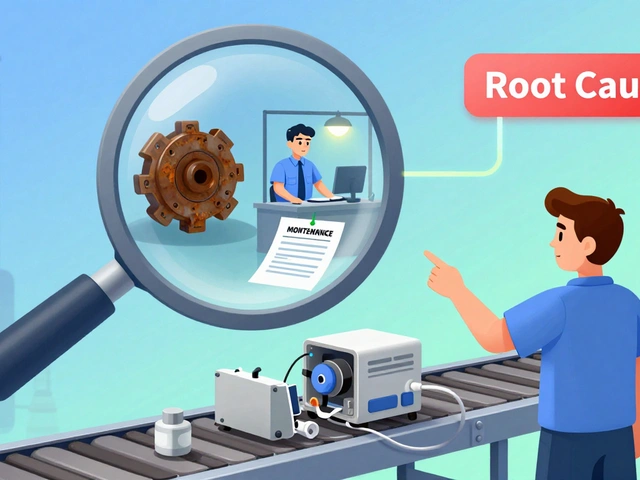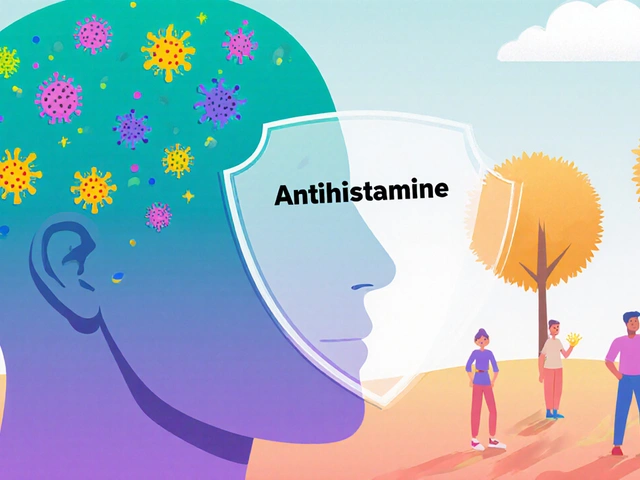When it comes to mental health, Paroxetine is a name that often crops up. But it's not a one-size-fits-all solution, and thankfully, there are plenty of other options on the table. We're going to chat about nine different alternatives that might just be what you're looking for.
Some of these are medications similar to Paroxetine, while others take a more natural or holistic approach. Let's get into it and see if there's something that matches your needs and lifestyle. After all, taking care of your mental health is one of the most important things you can do.
- Sertraline
- Fluoxetine
- Escitalopram
- Bupropion
- St. John's Wort
- Cognitive Behavioral Therapy
- Mindfulness Meditation
- Exercise and Physical Activity
- Omega-3 Fatty Acids
- Conclusion
Sertraline
When talking about alternatives to paroxetine, sertraline often comes up as a popular choice. It's another SSRI, or selective serotonin reuptake inhibitor, similar to paroxetine. This means it works on the same neurotransmitters in the brain to help improve mood and reduce anxiety.
One well-known fact about sertraline is how widely it's prescribed. This isn't just in the US, but globally. A big reason for this is its versatility. It's used not just for depression, but also for anxiety disorders, PTSD, and even OCD. How's that for multi-tasking?
"Sertraline remains one of the most effective and well-tolerated antidepressants available," notes Dr. Robert Smith, a psychiatrist who specializes in mood disorders.
Sertraline is typically considered safe and effective, but like any medication, it comes with pros and cons.
Pros
- Time-tested effectiveness for depression and anxiety.
- Lower risk of side effects compared to older antidepressants.
- Comparatively affordable and widely available.
Cons
- Common side effects like nausea and insomnia.
- May take weeks to notice improvements.
- Not a quick fix for everyone—requires patience.
Sertraline is like an old friend in the world of antidepressants—reliable, familiar, and often the go-to for doctors figuring out treatment plans. It's always good to have options, especially when dealing with something as important as mental health.
Fluoxetine
Fluoxetine is another popular option when looking for alternatives to Paroxetine. Often known by its brand name Prozac, it's been around since the late '80s, giving it quite a solid track record. It's primarily used to treat major depressive disorder, obsessive-compulsive disorder, and panic disorder, among other things.
So, how does this medication actually work? Well, it's part of a group called SSRIs—or selective serotonin reuptake inhibitors. It's like giving your brain's serotonin levels a little boost. With more serotonin floating around, the theory is your mood should get a lift too.
Pros
- Proven track record with extensive clinical usage.
- May improve mood, sleep, appetite, and energy levels.
- Long half-life, which means less severe withdrawal effects if a dose is missed.
Cons
- Can take 4 to 6 weeks to feel the full effects.
- Potential for side effects including nausea, insomnia, and anxiety.
- Not suitable for everyone, necessitating a doctor’s oversight for personalized treatment.
Deciding between Fluoxetine and Paroxetine alternatives often boils down to what suits your system best, balancing effectiveness with side effects. Always loop in a healthcare provider when making these decisions, as they can guide you towards the safest option tailored to your specific needs.
Escitalopram
If you're looking for a close alternative to paroxetine, then Escitalopram might be on your radar. It's another SSRI (Selective Serotonin Reuptake Inhibitor), which means it helps by increasing the levels of serotonin in your brain, giving that mood a bit of a boost.
Escitalopram is often prescribed for anxiety and depression, much like paroxetine. People like it because it's known for having relatively fewer sexual side effects compared to its counterparts. Plus, it's usually a bit easier on the stomach, which can be a big plus.
Pros
- Effective treatment for depression and anxiety disorders.
- Fewer sexual side effects compared to some other SSRIs.
- Well-tolerated with fewer gastrointestinal issues.
Cons
- May take a few weeks to notice the full effects.
- Possible side effects like insomnia and fatigue.
- Requires monitoring to avoid serotonin syndrome when combined with other medications affecting serotonin levels.
Escitalopram usually kicks in after a couple of weeks, so you'll need a bit of patience when starting. It's vital to stick with it as prescribed and have regular check-ins with your healthcare provider to make sure it's doing its job without unintended effects.
Interestingly, studies have suggested Escitalopram can offer comparable effectiveness to higher doses of older SSRIs but with lower doses and fewer side effects. This makes it a strong contender if you're searching for an alternative to paroxetine that could fit your lifestyle better.
Bupropion
Bupropion might not be as commonly talked about as Paroxetine, but it's definitely a contender when you're looking for alternatives in handling depression and other mental health issues. It's interesting because it works differently from typical SSRIs (selective serotonin reuptake inhibitors) like Paroxetine. Instead, Bupropion targets the neurotransmitters dopamine and norepinephrine, which can lead to a whole different set of effects.
One cool perk about Bupropion is that it's also approved for helping people quit smoking. Imagine tackling two birds with one stone: managing depression and kicking the smoking habit!
Pros
- Unique Mechanism: Different action mechanism can be advantageous if SSRIs aren't cutting it.
- Weight-Neutral: It's less likely to cause weight gain, which is a common issue with other antidepressants.
- No Sexual Side Effects: Lower risk of sexual side effects, which some folks find bothersome with SSRIs.
Cons
- Seizure Risk: It does carry a slight risk of seizures, especially at higher doses.
- Not for Anxiety: It might not be the best fit if anxiety is your primary concern, as it can sometimes increase it.
- Requires Prescription: Like Paroxetine, you'll need a doctor to prescribe it.
In studies, Bupropion has shown similar efficacy in treating depression as other antidepressants, so you don't have to worry about it being a less effective option. But, as always, how any medication works can vary from person to person. Discussing it with your healthcare provider is key to determining if it's the right fit for you.
St. John's Wort
St. John's Wort is a herbal remedy that's been catching some buzz as a potential alternative to antidepressants like Paroxetine. Known for its yellow flowers, this plant has been used for centuries in folk medicine. It’s said to help with everything from wounds to anxiety, but now it’s particularly noted for its possible benefits in managing mild to moderate depression.
How does it work? It's believed that St. John's Wort influences neurotransmitters in the brain, like serotonin, dopamine, and norepinephrine, similar to how some antidepressant meds function. That said, it’s a herbal supplement, not a magic bullet, and is usually best for milder cases.
Pros
- Natural origin, appealing to those avoiding synthetic medications.
- Fewer side effects compared to traditional antidepressants.
- Generally accessible and doesn’t require a prescription.
Cons
- Not recommended for severe depression.
- Potential interaction with other medications, including birth control pills and blood thinners.
- Can make skin sensitive to sunlight.
- Some inconsistent evidence on its effectiveness.
So, if you're considering an alternative to the mainstream options, St. John's Wort might be worth a shot. But remember, it's crucial to chat with a healthcare professional before jumping in, especially because of interactions with other medications. It’s all about finding what works best in your journey to a healthier mind.

Cognitive Behavioral Therapy
Cognitive Behavioral Therapy, or CBT, is like a workout for your brain, helping to tackle those pesky negative thoughts and behaviors. It’s about retraining your mind to think more positively and realistically, making it a supercharged alternative to traditional medications like Paroxetine.
CBT is structured and goal-oriented. It involves working with a therapist to develop practical strategies to combat patterns that contribute to depression and anxiety. You and your therapist will identify specific problems and set measurable goals to work towards with each session.
One cool thing about CBT is its flexibility. Whether you prefer one-on-one sessions or a group setting, there's something for everyone. And it's not just talk; there's homework involved! You might be keeping a journal of your thoughts or doing specific exercises to challenge your fears.
Pros
- Empowering: Gives you the tools to manage your mental health long-term.
- No side effects: No need to worry about the side effects that can come from medication.
- Effective: Can lead to significant improvements in mood and functioning.
Cons
- Time-consuming: Requires commitment and time to attend regular sessions.
- Not a quick fix: Results can take a while to manifest, unlike medication that might offer quicker relief.
- Cost: Therapy sessions can be expensive, especially without insurance coverage.
Many studies show CBT's effectiveness, often on par with medications for major depressive disorder. In fact, a blend of CBT and medication might even provide the best of both worlds for some people. So, if you’re looking for something beyond traditional meds, giving CBT a shot might be well worth your while.
Mindfulness Meditation
Alright, so let's chat about mindfulness meditation. This isn't about sitting cross-legged in silence for hours (unless that's your jam). It's about being present, truly focusing on the here and now. The idea is to observe your thoughts and feelings without judgment, kinda like watching them float by like clouds.
Meditation can help reduce stress, anxiety, and even depression—effects similar to what you'd get with medications like Paroxetine and other antidepressants. Researchers have found that meditation can actually change the brain's structure, boosting areas related to focus and emotional regulation. Cool, right?
So how do you start? It's simpler than you might think:
- Start small. Even just five minutes a day makes a difference.
- Find a quiet spot. It doesn’t need to be fancy, just a place where you won't be disturbed.
- Focus on your breath. Pay attention to each inhale and exhale, and when your mind wanders (which it will), gently bring it back to your breath.
- Use a guided meditation app if you need a nudge. There are tons of them out there, like Headspace or Calm.
A lot of folks mix in a bit of mindfulness with their daily routines, maybe during a run or while sipping tea. It’s flexible, so do what fits for you.
Here's a little nugget of data: a 2014 study showed that participants practicing mindfulness meditation experienced a 30% reduction in depression symptoms. And while those numbers sound good, remember that it takes consistency. Just like those mornings at the gym, the more you practice, the more you benefit.
Exercise and Physical Activity
When you're discussing alternatives to paroxetine, exercise often pops up as a heavy hitter. It might sound a bit cliché, but getting moving can actually do wonders for mental health. The cool science behind this involves the release of endorphins – those lovely chemicals in your brain that make you feel happy.
Doctors and therapists worldwide sing its praises. Dr. John Ratey, a professor of psychiatry at Harvard Medical School, has even mentioned,
"Exercise is the single best thing you can do for your brain in terms of mood, memory, and learning."
So, how does getting sweaty translate to better mental health? It's all about those natural mood lifters and breaking down stress hormones like cortisol. Here are some specific activities that can help:
- Walking or Jogging: Simple yet effective. Just 30 minutes a day can make a difference.
- Yoga: Combines movement with mindfulness, which is a double whammy for reducing anxiety and depression.
- Cycling: Great for cardio and lets you explore your surroundings.
These activities don’t just boost mood; they also help tackle insomnia and anxiety, all without any side effects like those pesky medication withdrawal symptoms.
Got numbers? You bet! A study in the journal ‘JAMA Psychiatry’ found that physical activity could reduce the chance of developing depression by 26%. That's a pretty convincing stat if you ask me.
| Activity | Recommended Frequency | Mood Improvement |
|---|---|---|
| Walking | 150 minutes/week | Moderate |
| Yoga | 2-3 sessions/week | High |
| Cycling | 75 minutes/week | Moderate |
So, next time you feel those blues creeping in, putting on those sneakers and hitting the road or mat might be just what your mental health ordered. Plus, it's mostly free and requires zero prescriptions!
Omega-3 Fatty Acids
Omega-3 Fatty Acids are like the trendy new supplement that everyone's talking about, and there's a reason for that. These natural supplements, specifically DHA and EPA, are found in things like fish and flaxseeds. People often associate them with heart health, but guess what? They might also lend a helping hand with mental well-being. We're starting to see more chatter about their potential to ease symptoms of depression, making them a possible alternative to traditional antidepressants like paroxetine.
Why are they worth considering? Well, they're safe for long-term use and come with a whole bunch of perks beyond mental health. Omega-3s are often praised for supporting cardiovascular health, and they don't pose a risk of addiction. But, they’re not a miracle cure-all. The evidence on their effectiveness for depression when taken alone is a bit patchy. You’ve got to be consistent with them, which means making them a regular part of your diet or supplement routine.
Pros
- Safe for long-term use
- Supports cardiovascular health
- No risk of addiction
Cons
- Limited evidence for standalone efficacy in treating depression
- Requires consistent intake to see benefits
So, if you’re someone who’s a fan of keeping things natural and you’re disciplined about taking supplements daily, Omega-3 Fatty Acids might just be a good option to explore. It’s always worth chatting with a healthcare provider to see if this is a match for your mental health goals.
Conclusion
Choosing the right paroxetine alternatives can sometimes feel like unravelling a riddle, but it's all about finding what fits you best. We've looked at some major players, from other medications like Sertraline and Fluoxetine, to more natural options like Omega-3 Fatty Acids and St. John's Wort.
Each alternative brings something unique to the table. The medications might be ideal if you're dealing with severe symptoms and need something clinically proven. On the flip side, natural supplements and therapies like Cognitive Behavioral Therapy and mindfulness meditation might be perfect if you're looking for a gentler approach with fewer side effects.
Here's a quick glance to make this easier.
| Alternative | Type | Main Pro | Main Con |
|---|---|---|---|
| Sertraline | Medication | Effective for depression | Potential side effects |
| Fluoxetine | Medication | Long-standing use | Dependency risk |
| Omega-3 Fatty Acids | Supplement | Supports brain health | Limited evidence |
Ultimately, the decision depends on your personal circumstances, needs, and how your body reacts to these treatments. It's always good to consult with a healthcare provider to make sure whatever choice you're considering aligns with your health goals. The best path is the one that helps you feel more like yourself.






Gabe Crisp
April 9, 2025 AT 10:53